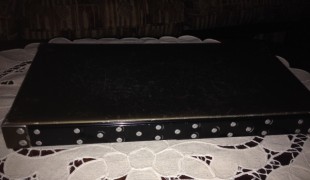- 7823
- 579
- 25
- 20
- 0
- Help Ukraine
Über die Lösung
Im Jahr 2008, Brian Nguyen studierte Psychologie an der University of Colorado-Denver, als er bei einem Motorradunfall verletzt und erlitt eine Verletzung des Rückenmarks. Nachdem er einige Zeit aus der Schule, Brian kehrte in UC-Denver, während immer noch anhaltenden Therapie. Er schloss sein Studium im Jahr 2011 mit einem Abschluss in Psychologie, aber seine Lebenserfahrungen das Leben mit einer Rückenmarksverletzung, führte ihn in eine andere berufliche Laufbahn zu verfolgen.
Es begann mit der Verabschiedung von Molly, ein Dackel-Mix, brachte er nach Hause. Brian merkte sofort, er habe Probleme unter Molly und seiner Schwester Yorkie-Cairn Mix, Riley, auf Wanderungen. Brian tat etwas Forschung und konnte nichts, die es einfacher machen würde. Das ist, wie die sciLeash, eine Haustierleine, die speziell für Menschen mit manuellen Rollstühlen machte, war geboren. Die sciLeash erlaubt eine Person im Rollstuhl, um beide Hände frei zu haben, während die Kontrolle über ihr Haustier.
Https://craighospital.org/blog/craig-grad-invents-pet-leash-for-people-using-manual-wheelchairs: Adaptiert
Sehen Sie das Video: https://www.youtube.com/watch?v=0xb6n0bxoJ0
Diese Lösung enthält keinen Hinweis weder auf die Verwendung von Arzneimitteln, Chemikalien oder biologische Stoffe (einschließlich Lebensmitteln) noch auf invasive Geräte, anstößige, kommerzielle oder inhärent gefährliche Inhalte. Diese Lösung wurde nicht medizinisch validiert. Vorsicht! Wenn Sie irgendwelche Zweifel haben, wenden Sie sich bitte an einen Arzt.
DISCLAIMER: This story was written by someone who is not the author of the solution, therefore please be advised that, although it was written with the utmost respect for the innovation and the innovator, there can be some incorrect statements. If you find any errors please contact the patient Innovation team via info@patient-innovation.com
-
-
346
-
0
-
4622

Schritt artikulieren und mobile
MOVING IN A WHEELCHAIR: Moving using a wheelchair.
Traveling
Urban exploration
Paralysis
Assistive Daily Life Device (to help ADL)
Walking Aid (wheelchair/walker/crutches)
Restoring mobility
Promoting self-management
Managing Neurological Disorders
Building Supportive Community Relationships
Promoting inclusivity and social integration
Recovering from Traumatic Injuries
Maintaining Balance and Mobility
To improve Treatment/Therapy
Raise awareness
Caregiving Support
Neurology
Orthopedics
Rheumatology
Portugal
-
-
-
504
-
0
-
7612

Website, um Menschen mit Behinderungen gehen
Social interaction
Urban exploration
Shopping
Attend Concerts/Performances
MOVING IN A WHEELCHAIR: Moving using a wheelchair.
Neuromuscular Disorders
Bone Disorders (Decalcification, Bone Deformity, Bone Fracture, Bone Infection)
Cervical spinal cord injury/Tetraplegia
Website
Online service
Strategy/Tip
Gait abnormalities (e.g., walking difficulties, unsteady gait)
Difficulty coordinating movements
Stiffness or rigidity (difficulty moving)
Paralysis of the legs and lower body
Restoring mobility
Promoting self-management
Building Supportive Community Relationships
Promoting inclusivity and social integration
Preventing (Vaccination, Protection, Falls, Research/Mapping)
Raise awareness
Caregiving Support
Neurology
Orthopedics
Rheumatology
United Kingdom
-
-
-
282
-
0
-
3113

Wie zwei Freunde mit Behinderungen und harter Arbeit das Reisen um die Welt für alle zugänglich machten.
MOVING IN A WHEELCHAIR: Moving using a wheelchair.
Camping
Urban exploration
Neuromuscular Disorders
Website
Tremors
Muscle cramps or spasms
Stiffness or rigidity (difficulty moving)
Muscle weakness
Loss of balance
Trouble with fine motor skills (e.g., writing, buttoning clothes)
Numbness or tingling in the extremities
Twitching or involuntary movements (myoclonus)
Vertigo
Restoring mobility
Enhancing health literacy
Promoting self-management
Promoting inclusivity and social integration
Maintaining Balance and Mobility
Preventing (Vaccination, Protection, Falls, Research/Mapping)
Raise awareness
Caregiving Support
General and Family Medicine
Neurology
United States
-
 de
de